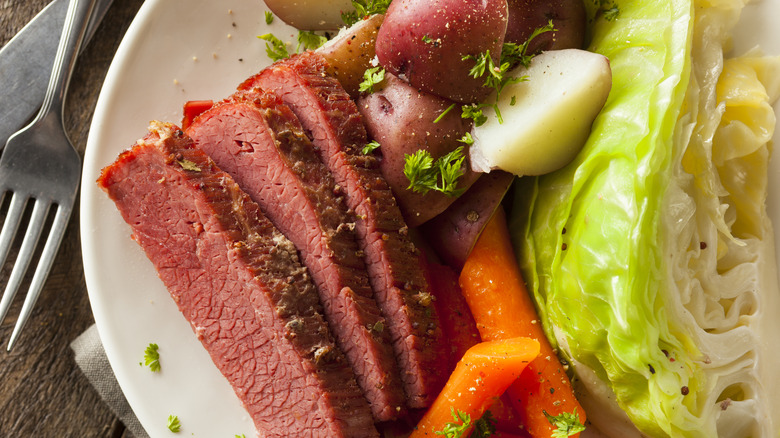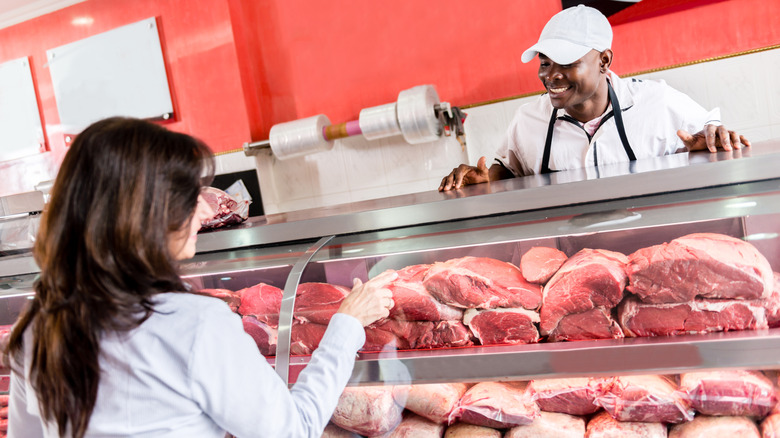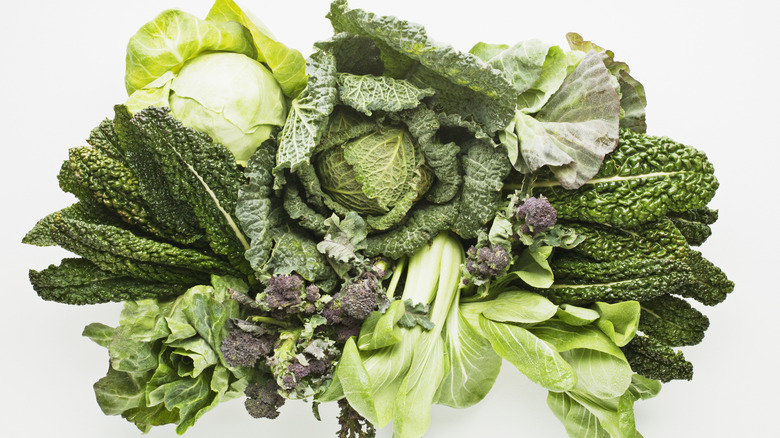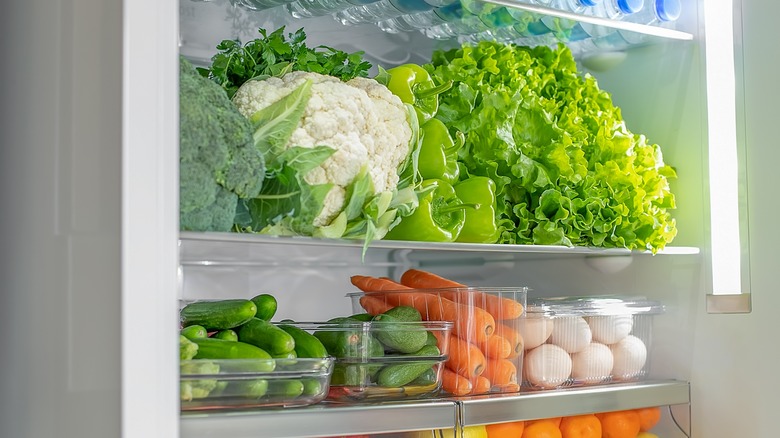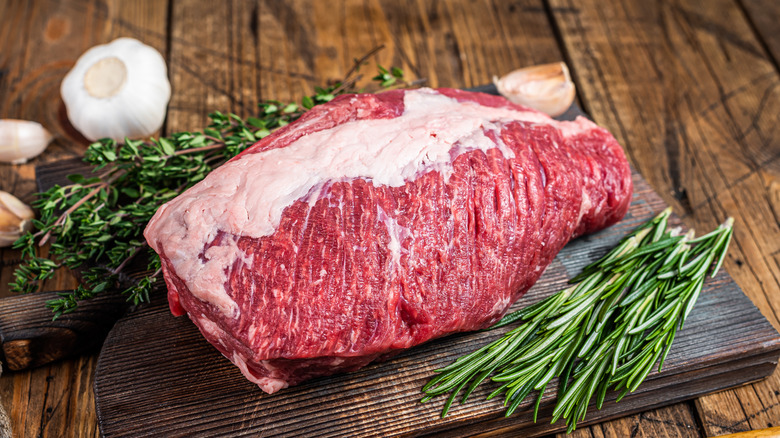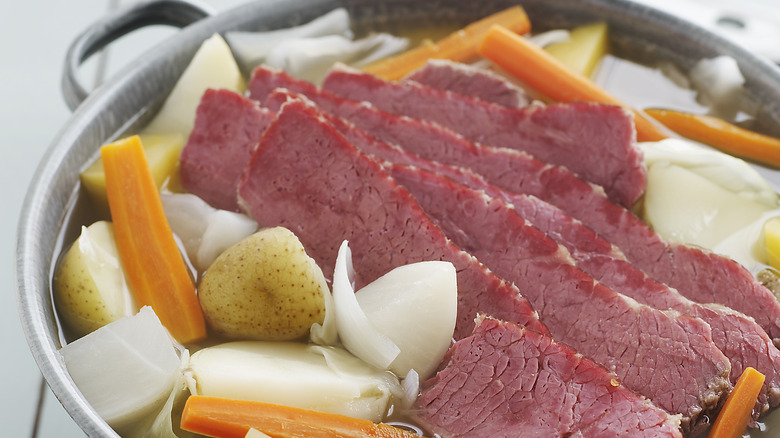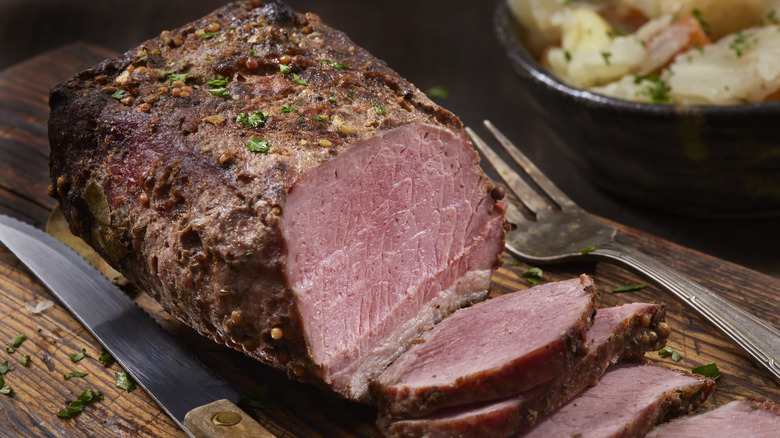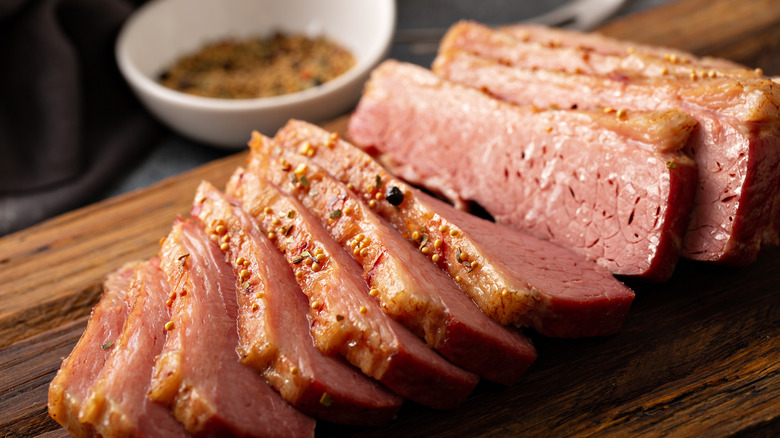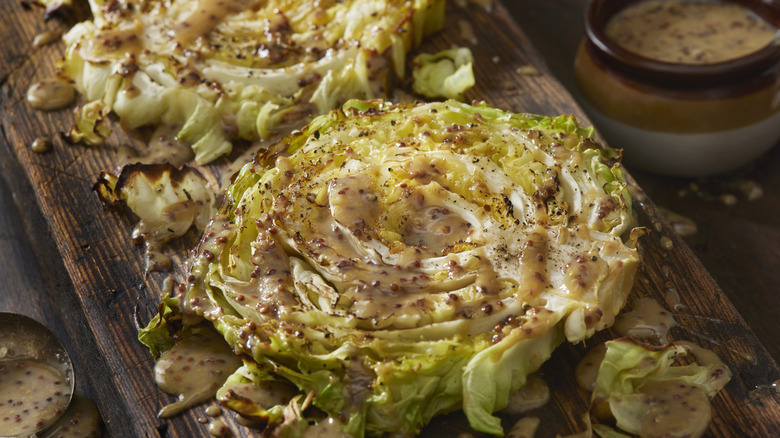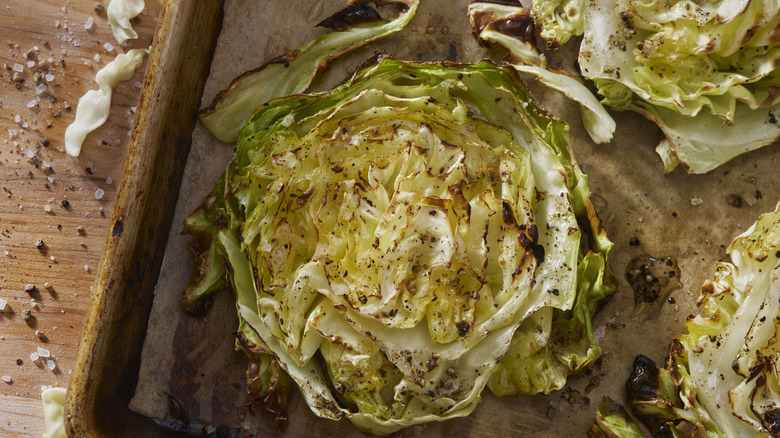10 Tips You Need When Cooking Corned Beef And Cabbage
Be it a St. Patrick's Day tradition or a run-of-the-mill Sunday night, a steaming hunk of succulent corned beef alongside traditional boiled or crispy roasted cabbage is a comforting and filling meal familiar to almost everyone. The salt-cured beef brisket is called "corned" after the corns of large rock salt used to preserve the meat. The popularity of corned beef and cabbage is in part thanks to 19th and 20th-century Irish and Jewish immigrants in New York, who lived close to each other and made use of the cheaper beef products available in the United States. Potatoes and cabbage — cheap and readily available vegetables — were frequently featured alongside the beef to round out a meal and help stretch food for larger families.
Today, corned beef and cabbage are still served hand-in-hand on dinner plates and in Reubens a la sauerkraut and corned beef. If you're feeling the urge to cook up your very own rendition, there are a few tips and tricks to nailing the meal; from choosing the right cut of meat to knowing when and how to season your cabbage. You can even decide whether you want to go out on a limb and create your own cured and corned beef or skip the eight-day brining time and buy a ready-to-cook corned beef. Here are some tips for cooking corned beef and cabbage.
1. Choose the right cut of meat
If you've made the leap and are prepared mentally to create your own corned beef and cabbage feast, the first step is choosing the right cut of meat. There are two ways to approach this: you can either buy a cut of beef and corn it yourself, or you can buy an already cured corned beef. If you'd like to try to create your own corned beef, you'll need a whole flat or point-cut beef brisket — allowing about half a pound for each person you're intending to feed. You can ask your butcher for this cut or find it in the grocery store, especially around St. Patrick's Day. If you're going this route, make sure you're buying your beef at least 10 days before you intend to serve your corned beef, as the corning process takes anywhere from six to eight days, depending on which recipe you're following.
If you don't have eight days to create a meal (understandable), you may be more apt to choose the pre-corned beef available in the grocery store. You'll want to search for a corned beef brisket with a spice packet, again, allowing about half a pound for each person you intend to feed. Pad that number a bit, though, if you want and need leftovers for corned beef sandwiches, corned beef hash, and other delicious leftovers. It'll be up to you whether you make use of the spice packet or not, but the hard work — corning and curing the beef — will already be done for you.
2. Choose the right cabbage
Now that the perfect piece of brisket or the perfect corned beef is sitting in your shopping cart and ready to be the star of your dinner plate, you'll need to find the supporting act — the cabbage — and choose the right one for the job. If you're creating a traditional corned beef and cabbage dish, you'll more than likely be on the lookout for a head of white or green cabbage. The more oblong Napa cabbages or delicately flavored Savoy cabbages can be used but may be more difficult to find. Red cabbage can be used if you're braising or quickly stir-frying, although it's less traditional.
Let's say you're going with the traditional white or green cabbage. While you're perusing your choices in the produce aisle, you'll want to pick one with crisp and fresh-looking outer leaves. You want it to be firm and heavy, and outer leaves should be brightly white or lime green.
3. Store your cabbage correctly
Once you've secured your corned (or un-corned) beef and cabbage, it's time to properly store and stow them away until it's time to create your culinary masterpiece. If you're going to be corning and curing your beef yourself, you'll need to store the cabbage until you're ready to cook and serve; so, for six to eight days. Cabbage, as a leafy green, needs to be stored in the refrigerator to stay as crisp and fresh as possible. If you bought your cabbage at the grocery store, you can put it in your fridge in the plastic produce bag you snagged along with it. This should keep that head of cabbage fresh for about 10 days. If you see the outer leaves starting to discolor or become wilted, be sure to remove them before cooking time.
If, for whatever reason, you're working with a head of cabbage that's already been cut in half or otherwise has its interior showing, storage works a bit differently. Use plastic wrap to cover the cut side of the cabbage and store it cut side down in the refrigerator. Before you cook with it, cut a slice off of the pre-cut area to get rid of any dry bits and discoloration.
4. Rinse your meat
As we mentioned above, there are going to be several ways to cook and prep your corned beef. You may have gotten the ready-to-cook corned beef, packaged with a bundle of spices; or the point-cut beef brisket which you'll be corning and curing yourself over six to eight days. Regardless of which direction you're going cooking-wise, though, one prep step should be taken: rinse your meat.
You should rinse your uncooked corned beef before boiling, roasting, or slow-cooking it. So, if you've purchased a ready-to-cook corned beef, once you remove it from the packaging, rinse it first in cold water, and then proceed with your recipe. If you've corned the beef yourself, once you've removed it from the brine and are ready to move on to cooking, rinse the meat first. Rinsing is important as it will help to remove any residual salt left on the corned beef. Without rinsing, your corned beef could come across as far too salty. Plus, you can always add salt at a later step. Remember, too, that rinsing won't make your corned beef bland. The corning process — like any brining and curing process — infuses the meat with salt and spice. Rinsing simply takes the residual salt off of the outside.
5. Boiling your corned beef
There are multiple ways to attack the actual cooking of your corned beef. One of the most classic, traditional, and frankly, easiest ways to make the dish is to boil the beef in either water, Guinness, or a melange of broth and spices.
Whether your using a ready-to-cook corned beef or one you've made yourself, the recipe(s) remain mostly the same. Rinse the meat with water (as directed above) to remove residual salt. Then, place in a large Dutch oven and cover with water, Guinness, or a one-to-one combination of the two. You want enough liquid to submerge the meat by about an inch. Add two or three bay leaves, two medium chopped carrots; a medium onion, quartered; one chopped celery rib; a tablespoon of whole coriander; a tablespoon of whole yellow mustard seeds; and a tablespoon of whole black peppercorns. You can, of course, utilize the spice packet that accompanies a ready-to-cook corned beef. Bring everything to a boil over medium-high heat, then reduce heat to low and simmer until the beef is tender. This should take about 3 hours for a 4-pound brisket. Once the beef is ready, remove it from the pot — discarding the rest. Let sit and rest for 10 to 15 minutes before slicing.
6. Roasting your corned beef
If you're not in the mood for traditional boiled corned beef, there are those that go the roasted route. Doing so results in a still juicy, moist piece of beef, but also delivers a delightful crust on the outside — something you simply aren't going to get if you're going the boiled route. Some folks find it easier, too, as you're not watching a pot on the stove for several hours, praying to the corned beef gods that it doesn't boil over.
To roast your corned beef, preheat your oven to 350 F. After rinsing your corned beef in cold water, pat it dry and place it fat cap side up in a roasting pan with a roasting rack fitted inside. You can sprinkle herbs and spices over and around the outside of the beef at this point, but it isn't necessary. Once your corned beef is rubbed and seasoned (or not), place it in the roasting pan, add about 6 cups of water around the outside (enough to come up about ½ inch on the corned beef), then cover the entire roasting pan tightly with foil. Roast for 2 to 3 hours or until the meat's internal temperature reaches 195 F.
7. Slow cooking your corned beef
Last but not least, you have the option of using the tried and true slow cooker for your corned beef. This option is probably the most hands-off, so if you're trying to get some work done around the house and then present a perfectly elegant corned beef for dinner with little to no struggle on your part, this is the route for you. Recipes for corned beef in a slow cooker abound, but it's really up to you how much prep you do beforehand as far as getting the beef into your slow cooker and getting it going.
Before placing your corned beef in the slow cooker, you can sear the outside of the meat quickly in a hot skillet to add a bit of crust and flavor. Once you sear (or don't sear) your meat, place it in the slow cooker fat side up. If you have a spice packet that came with a ready-to-cook corned beef, add it to the slow cooker at this point. If you don't, add a tablespoon each of whole black peppercorns, whole cloves, whole coriander, whole yellow mustard seeds, and brown sugar. From there, add your vegetables and other accoutrement, cooking on low for 8 hours or so, then cranking it up to high for the final hour of cooking.
8. Prepping and seasoning your cabbage
Now that your meat is well on its way to becoming the centerpiece of your plate, it's time to address the cabbage. Depending on how you intend to cook said leafy green, you'll need to do a bit of prep work before getting it ready to go. Generally, when serving cabbage with corned beef, it's either boiled or roasted. If you're intending to roast your cabbage, you'll need to remove the cabbage from the refrigerator and wash it. We're not looking for anything extreme here; just ensure that the outer leaves are clean and clear of any dirt or debris; any discolored or wilted leaves are removed, and the outside generally looks presentable.
If you'll be roasting, cabbage steaks could be the way to go. Place the slices on a baking sheet lined with parchment paper, then use a brush or your hands to rub on olive oil, salt, and pepper. You can also adjust seasonings depending on your personal tastes. Add lemon juice, fresh herbs, and even parmesan cheese, if you like.
If you're going to be boiling your cabbage, you'll want to core it — that is, remove the stem and hard center — and then quarter it. Make sure any loose or wilted leaves have been removed. There's no real need for seasoning in this scenario since the cabbage will take on the flavor of the cooking liquid as it boils alongside your corned beef.
9. Roast the cabbage while the corned beef cooks
Your cabbage is prepped and your corned beef is nearly done cooking. If you've chosen what we believe is the more delicious option for cooking cabbage (no disrespect to boiled cabbage, but roasted is just ... better), it's time to get that cruciferous beauty in the oven so you can time it hitting the plate at the same time as your main attraction. If you've already prepped and seasoned your cabbage and have them ready in "steak" form on a parchment-lined baking sheet, you'll want to put them into a preheated oven at 400 F. If you're roasting your corned beef in the oven and it's set to 350 F, you can still cook your cabbage; it just may take a bit longer. Once the cabbage is in the oven, keep an eye on it — when it starts to turn golden brown along the tops and edges, it's done. To serve, you can either keep the cabbage "steaks" whole or you can cut them up for a shredded roasted cabbage bed perfect for nestling corned beef on top of.
If you do choose to boil your cabbage, you can, as mentioned, add it to the boiling pot alongside your corned beef. You can also cook it separately. Prep your cabbage as discussed above, then add it to a pot of boiling water with salt. Reduce heat to low and simmer for about 10 to 12 minutes, then remove and drain the cabbage. Season with salt, pepper, and butter, then serve alongside your corned beef.
10. Let your meat rest and cut it properly
You did it! You created the perfect dish of corned beef and cabbage. It's going to be the perfect addition to your St. Patrick's Day table, or simply the best weekend evening meal, ever. But before you cut into your corned beef and start chowing down, you'll need to rest and then properly cut the meat.
Corned beef is considered safe to eat once the internal temperature has reached 145 F with at least a three-minute rest time. Once you've checked that your beef is where it needs to be, remove it from the oven or the boiling liquid to a platter and let it rest for at least ten minutes. Doing so will allow the beef's juices to redistribute — whether it's been roasted, slow-cooked, or boiled — as well as allow the beef to cool. Slicing into it as soon as it comes out of the oven or slow cooker would cause juices to flow out of it and the beef to be served too hot.
Once the corned beef has rested, it's time to slice. Grab a very sharp knife and cut against the grain into quarter or half-inch slices, depending on the preferences of you and your guests. Remember that to find the grain, you can flip the meat on its side and see which way the fibers within the cut run. Lay the meat back down so that the fibers run diagonally away from you, then slice and serve.
